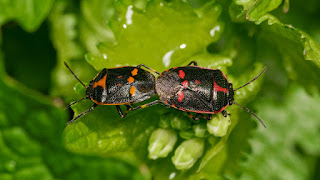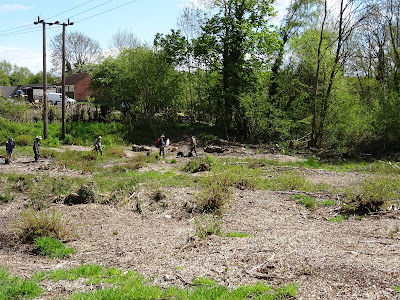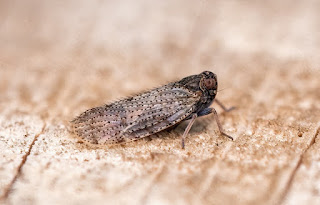Tuesday 25th May 2021
Joy of Wildlife recommenced last Wednesday (19th May) with a visit to the recently declared local nature reserve at Dawley Hamlets in Telford. This is a site of mixed habitats including woodland, pools, grassland and former pit mounds. It is a large site spread across several unconnected areas. There was no way that we could visit all the areas so we concentrated on the area to the south of the main pools.I arrived at the meet point rather early (unusual for me) and took a look at one of the pools which is named The Dandy on my map.
As you can see in amongst the horrendous weather that has assaulted us over the last few weeks we were blessed to start our visit on a sunny day.
Would it last?
As you can also see there is nothing other than a coot on the lake.
A pair of Mallard did glide across in the middle distance as soon as I put my camera away!
The coot in the above photograph was a member of a small family group close to where I was standing.
I got my camera out again and the Coots immediately made a bolt for it. This is the best I could do:
By the time I got back to the car park others had gathered. Introductions were made, pleasantries exchanged, but no hugging. We also had a look at the latest Insect Field Guide by Paul Brock that a couple within the group had purchased and one had brought along. (A brief description can be found at the end of this report.)
Eventually we ambled off taking a path along the southern edge of a fishing pool. The vegetation was luxuriant but yielded very little of interest apart from a Sparrowhawk that flashed across a field to our left. However, there were plenty of damp areas and dead wood to warrant investigation by those of us interested in those habitats.
A fork in the path always causes confusion. If I suggest we go a certain direction the opposite course is invariably taken. Fortunately the decision was taken out of my hands and we set off (in the direction I would have suggested).
Passing a holly tree I noticed it covered in the leaf mine of the Holly leaf-mining fly Phytomyza ilicis:
Carrying on through the shade of the woodland we came across a sunlit area where the vegetation had been cleared several years ago to protect the overhead wires. We found a Wasp beetle on a leaf taking in the sun to warm itself up .
Nearby was a swarm of male Adela reaumurella, a small, long-horn moth, "dancing" around a small silver birch in the frantic search for a suitable mate.
Carrying on with our ramble we came across a second strip under power lines. Here the vegetation had been decimated recently.
Nevertheless the green shoots of recovery were apparent.
Having done some searching in this area we realised it was warm, sheltered from the breeze and equipped with felled tree trunks and stumps that we could sit on.
Lunch was taken.
Refuelled, we pressed on.
A sycamore caught the attention of our dipterist, which, in turn, caught the attention of others.
I left them to it and moved on to a pool at the bottom of the site. As I walked I was distracted by a butterfly and followed it until it eventually came to a rest. A Speckled wood.
Eventually I got to the pool.
A sturdy board walk has been constructed across it. Ideal for pond-dipping and taking photographs.
No-one fell in.
Amongst the creatures dipped from the pond was a Water measurer.
 |
| Photograph: David Williams |
A single cuckoo flower was growing at the edge of the pool.
This plant is known by a variety of local names including Lady's mantle and Milk-maids but its scientific name is Cardamine pratensis.
If you look carefully and have good eyesight you may notice eggs on cuckoo flower.
 |
| Photograph: David Williams |
This egg has been laid by an Orange-tip butterfly.
The weather had been too good to last... it rained, causing a mad scramble for waterproofs.
We started the trudge back to the cars and noticed this down-looker fly, Rhagio scolopaceus, sheltering from the rain on the trunk of a tree.
An nearby there were a number of small beetles clustered together in the middle of a Dandelion.
We had now reached the other end of the "decimated" strip.
The sun reappeared.
And it was warm.
A chance to dry out.
There was a bit more vegetation on this section of the wayleave and it was flat and easily accessible. There were lots of clumps of Garlic mustard and other crucifers and on one of these clumps we noticed around twenty, if not more, Sloe bugs, Dolycoris baccarum.
 |
| Photograph: David Williams |
And in amongst these were half a dozen or so Crucifer shieldbugs, Eurydema oleracea.
 |
| Photograph: David Williams |
This shieldbug has at least two other common names - Brassica shieldbug and Cabbage shieldbug. All very confusing. It also comes in different colours - red and orange as above and white (or cream) as below.
 |
| Photograph: David Williams |
A Bishop's Mitre was noticed nearby
 |
| Photograph: David Williams |
And the bugs kept coming ...
Vacuum sampling a patch of Forget-me-nots revealed - no, not a Forget-me-not shieldbug - but a Tortoise shieldbug.
 |
| Photograph: Davis Williams |
And in this sample we also found a tortoise beetle, Cassida viridis.
In the same area a male scorpion fly, Panorpa communis, was photographed.
 |
| Photograph: David Williams |
As if this was not enough for one tiny area, this little patch had one more surprise for us. A beetle that looks like a stretched soldier beetle but is, in fact, a ship timber beetle, Hylecoetus dermestoides.
 |
| Photograph: David Williams |
This little area should be a National Nature Reserve!
After all this excitement we returned to the car park and made our way home.
My thanks to the Friends of Dawley Hamlets for inviting us to survey and to David for providing so many excellent photographs.
But before I go there is also some catching up to do with photographs that have been sent to me recently.
Our correspondent, Graham, has been out and about in the Church Stretton area and has sent me the following photographs.
A Buff-tailed bumble bee:
 |
| Photograph: Graham Wenman |
A micro-moth, Esperia sulphurella:
 |
| Photograph: Graham Wenman |
In my last report I mentioned that we had found Glow-worm larvae at Stretton Westwood Quarry. I have now been sent a couple of photographs of the larvae.
First an early instar larva which is tiny compared to the adult insect (but not the weevil next to it):
 |
| Photograph: David Williams |
Second a large larva that must be approaching the adult stage.
 |
| Photograph: David Williams |
In addition to Glow-worms the quarry is a good site for Dingy skipper butterflies.
 |
| Photograph: David Williams |
Another insect found in the quarry is the small inconspicuous ladybird Scymnus haemorrhoidalis which lives up to its name with a red tip to its abdomen, which can be seen in this composite photograph, as well as its head and the front and sides of its pronotum.
 |
| Photograph: David Williams |
To finish, three photographs of Downy emerald dragonflies found at Oak Mere SSSI in Cheshire by Pete Boardman.
A newly emerged adult:
 |
| Photograph: Pete Boardman |
An adult:
 |
| Photograph: Pete Boardman |
My thanks to Graham, David and Pete for their photographs.
Britain's Insects by Paul Brock:
 |
| Photograph: Neil Nash |
The first thing to say is that it is a weighty tome - not the content, but the physical weight; not my ideal for a field guide. But it is the content that counts, not the weight.
Despite its title it does not attempt to cover all insects but concentrates, so it claims, on those that can be identified in the field - apparently 1653 are included.
It seems to be well laid out with photographs and text in discreet sections on each page rather than in Brock's other book "A comprehensive guide to Insects of Britain and Ireland" where the right hand page is packed with photographs and the left hand page with lots of text, which can be confusing.
Unfortunately I have not seen enough of the text to judge how good it is in allowing you to identify insects in the field, and avoiding the trap of seeing a picture that matches your insect and thinking "that must be it", without the text telling you there are several other species that look more or less the same.
One novelty is that it includes QR codes (whatever they are) that provide links to sound recordings of the calls of the grasshoppers and crickets. This would be a handy feature if you have a device in the field on which you can listen to the recordings and you still have the hearing range to hear the live insects.
It is probably a book for the generalist rather than the specialist.
Finally the price. It can be obtained for around £20 which seems very reasonable.
That's all folks








































































